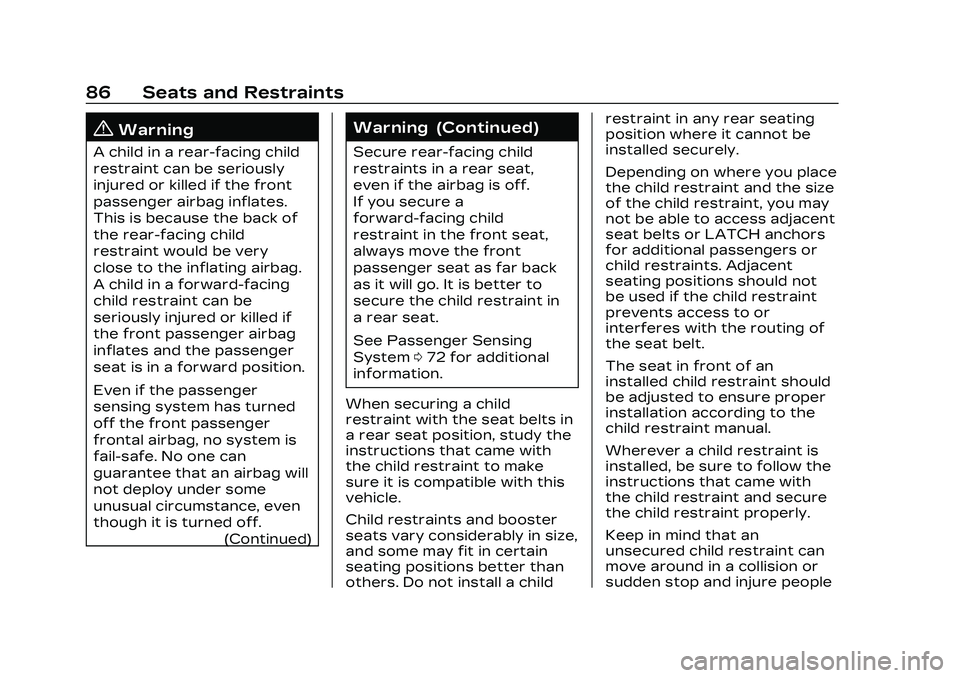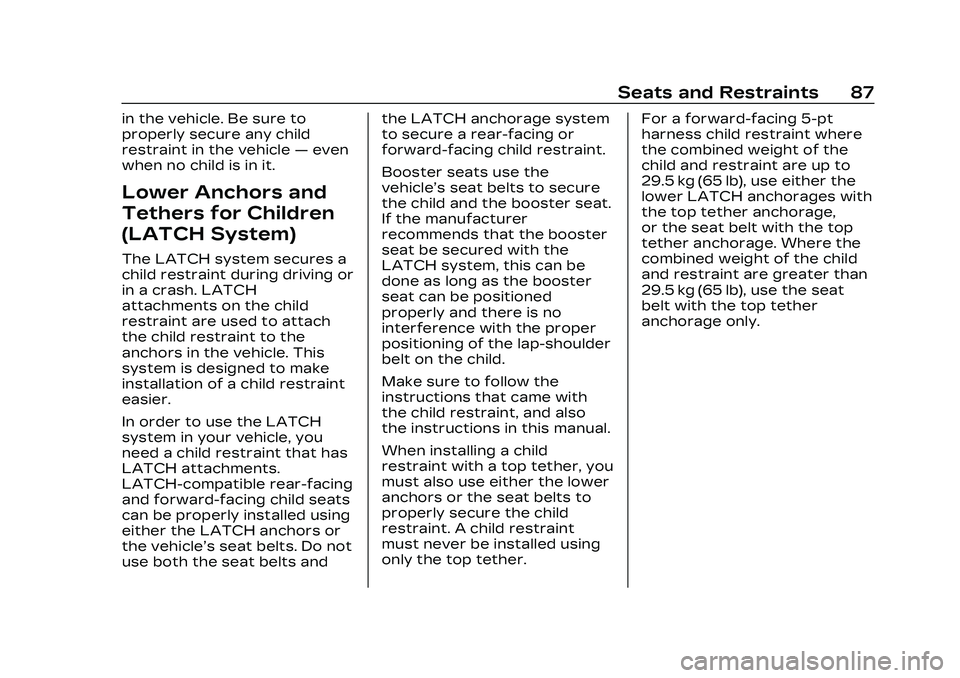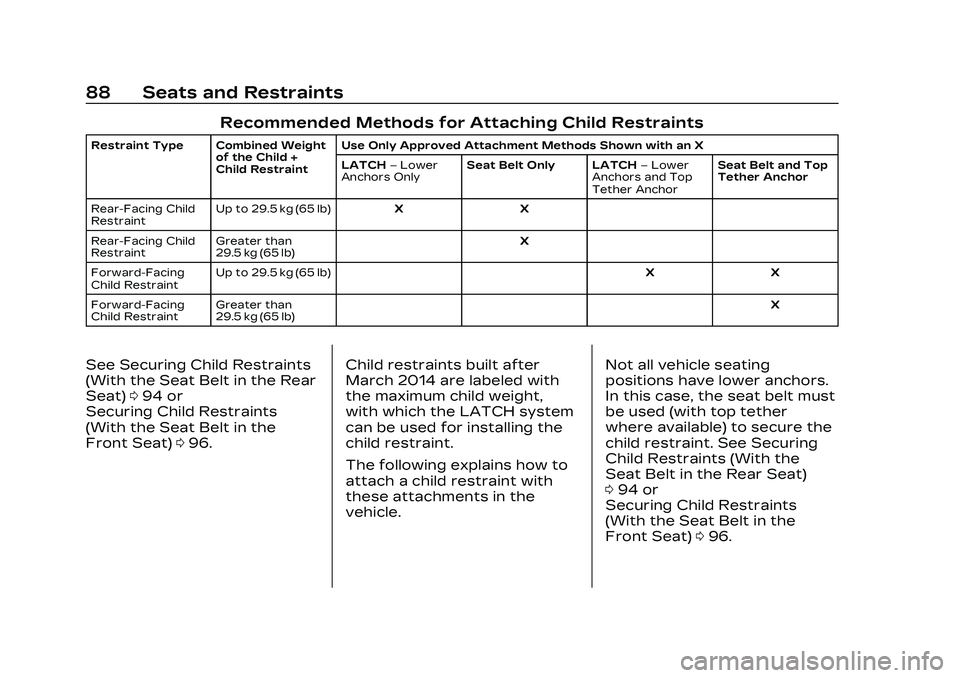ECU CADILLAC CT5 2023 User Guide
[x] Cancel search | Manufacturer: CADILLAC, Model Year: 2023, Model line: CT5, Model: CADILLAC CT5 2023Pages: 526, PDF Size: 6.85 MB
Page 70 of 526

Cadillac CT5 Owner Manual (GMNA-Localizing-U.S./Canada-16500419) -
2023 - CRC - 5/6/22
Seats and Restraints 69
Warning (Continued)
causing severe injury or
even death. The path of an
inflating airbag must be kept
clear. Do not put anything
between an occupant and an
airbag, and do not attach or
put anything on the steering
wheel hub or on or near any
other airbag covering.
Do not use seat accessories
that block the inflation path
of a seat-mounted side
impact airbag.
Never secure anything to
the roof of a vehicle with
roof-rail airbags by routing a
rope or tie‐down through
any door or window opening.
If you do, the path of an
inflating roof-rail airbag will
be blocked.
When Should an
Airbag Inflate?
This vehicle is equipped with
airbags. See Airbag System
065. Airbags are designed to
inflate if the impact exceeds
the specific airbag system's
deployment threshold.
Deployment thresholds are
used to predict how severe a
crash is likely to be in time for
the airbags to inflate and help
restrain the occupants. The
vehicle has electronic sensors
that help the airbag system
determine the severity of the
impact. Deployment
thresholds can vary with
specific vehicle design.
Frontal airbags are designed
to inflate in moderate to
severe frontal crashes to help
reduce the potential for
severe injuries, mainly to the
driver's or front outboard
passenger's head and chest. Whether the frontal airbags
will or should inflate is not
based primarily on how fast
the vehicle is traveling.
It depends on what is hit, the
direction of the impact, and
how quickly the vehicle
slows down.
Frontal airbags may inflate at
different crash speeds
depending on whether the
vehicle hits an object straight
on or at an angle, and whether
the object is fixed or moving,
rigid or deformable, narrow
or wide.
Frontal airbags are not
intended to inflate during
vehicle rollovers, in rear
impacts, or in many side
impacts.
In addition, the vehicle has
advanced technology frontal
airbags. Advanced technology
frontal airbags adjust the
restraint according to crash
severity.
Page 74 of 526

Cadillac CT5 Owner Manual (GMNA-Localizing-U.S./Canada-16500419) -
2023 - CRC - 5/6/22
Seats and Restraints 73
certain conditions. No other
airbag is affected by the
passenger sensing system.
The passenger sensing
system works with sensors
that are part of the front
outboard passenger seat and
seat belt. The sensors are
designed to detect the
presence of a properly seated
occupant and determine if the
front outboard passenger
frontal airbag and knee airbag
should be allowed to inflate
or not.
According to accident
statistics, children are safer
when properly secured in a
rear seat in the correct child
restraint for their weight
and size.
Whenever possible, children
aged 12 and under should be
secured in a rear seating
position.Never put a rear-facing child
seat in the front. This is
because the risk to the
rear-facing child is so great,
if the airbag inflates.
{Warning
A child in a rear-facing child
restraint can be seriously
injured or killed if the
passenger frontal airbag
inflates. This is because the
back of the rear-facing child
restraint would be very
close to the inflating airbag.
A child in a forward-facing
child restraint can be
seriously injured or killed if
the passenger frontal airbag
inflates and the passenger
seat is in a forward position.
Even if the passenger
sensing system has turned
off the front outboard
passenger airbag(s), no
system is fail-safe. No one
can guarantee that an
(Continued)
Warning (Continued)
airbag will not deploy under
some unusual circumstance,
even though the airbag(s)
are off.
Never put a rear-facing child
restraint in the front seat,
even if the airbag is off.
If securing a forward-facing
child restraint in the front
outboard passenger seat,
always move the seat as far
back as it will go. It is better
to secure child restraints in
the rear seat. Consider
using another vehicle to
transport the child when a
rear seat is not available.
The passenger sensing
system is designed to turn off
the front outboard passenger
frontal airbag and knee
airbag if:
.The front outboard
passenger seat is
unoccupied.
Page 76 of 526

Cadillac CT5 Owner Manual (GMNA-Localizing-U.S./Canada-16500419) -
2023 - CRC - 5/6/22
Seats and Restraints 75
4. Reinstall the child restraintfollowing the directions
provided by the child
restraint manufacturer and
refer to Securing Child
Restraints (With the Seat
Belt in the Rear Seat) 094
or
Securing Child Restraints
(With the Seat Belt in the
Front Seat) 096.
Make sure the seat belt
retractor is locked by
pulling the shoulder belt all
the way out of the
retractor when installing
the child restraint, even if
the child restraint is
equipped with a seat belt
lock off. When the
retractor lock is set, the
belt can be tightened but
not pulled out of the
retractor.
5. If, after reinstalling the child restraint and
restarting the vehicle, the
ON indicator is still lit, turn
the vehicle off. Then
slightly recline the vehicle seatback and adjust the
seat cushion, if adjustable,
to make sure that the
vehicle seatback is not
pushing the child restraint
into the seat cushion.
Also make sure the child
restraint is not trapped
under the vehicle head
restraint. If this happens,
adjust the head restraint.
See Head Restraints
043.
6. Restart the vehicle.
The passenger sensing
system may or may not turn
off the airbags for a child in a
child restraint depending upon
the child’s size. It is better to
secure the child restraint in a
rear seat. Never put a
rear-facing child restraint in
the front seat, even if the ON
indicator is not lit.If the Off Indicator Is Lit
for an Adult-Sized
Occupant
If a person of adult size is
sitting in the front outboard
passenger seat, but the OFF
indicator is lit, it could be
because that person is not
sitting properly in the seat or
that the child restraint locking
feature is engaged. Use the
following steps to allow the
system to detect that person
and enable the front outboard
passenger frontal airbag and
knee airbag:
Page 83 of 526

Cadillac CT5 Owner Manual (GMNA-Localizing-U.S./Canada-16500419) -
2023 - CRC - 5/6/22
82 Seats and Restraints
Warning (Continued)
5.5 kg (12 lb) infant will
suddenly become a
110 kg (240 lb) force on a
person's arms. An infant or
child should be secured in an
appropriate child restraint.
{Warning
Children who are up against,
or very close to, any airbag
when it inflates can be
seriously injured or killed.
Never put a rear-facing child(Continued)
Warning (Continued)
restraint in the front
outboard seat. Secure a
rear-facing child restraint in
a rear seat. It is also better
to secure a forward-facing
child restraint in a rear seat.
If you must secure a
forward-facing child
restraint in the front
outboard seat, always move
the front passenger seat as
far back as it will go.
Child restraints are devices
used to restrain, seat,
or position children in the
vehicle and are sometimes
called child seats or car seats.
There are three basic types
of child restraints:
.Forward-facing child
restraints
.Rear-facing child restraints
.Belt-positioning booster
seats
The proper child restraint for
your child depends on their
size, weight, and age, and also
on whether the child restraint
is compatible with the vehicle
in which it will be used.
For each type of child
restraint, there are many
different models available.
When purchasing a child
restraint, be sure it is
designed to be used in a
motor vehicle and is designed
by a genuine child restraint
manufacturer. If it is, the child
restraint will have a label
Page 84 of 526

Cadillac CT5 Owner Manual (GMNA-Localizing-U.S./Canada-16500419) -
2023 - CRC - 5/6/22
Seats and Restraints 83
saying that it meets federal
motor vehicle safety
standards.
The instruction manual that is
provided with the child
restraint states the weight
and height limitations for that
particular child restraint. In
addition, there are many kinds
of child restraints available for
children with special needs.
{Warning
To reduce the risk of neck
and head injury in a crash,
infants and toddlers should
be secured in a rear-facing
child restraint until age two,
or until they reach the
maximum height and weight
limits of their child restraint.
{Warning
A young child's hip bones
are still so small that the
vehicle seat belt may not
remain low on the hip bones,
as it should. Instead, it may
settle up around the child's
abdomen. In a crash, the belt
would apply force on a body
area that is unprotected by
any bony structure. This
alone could cause serious or
fatal injuries. To reduce the
risk of serious or fatal
injuries during a crash,
young children should
always be secured in an
appropriate child restraint.
Child Restraint
Systems
Rear-Facing Infant Restraint
A rear-facing child restraint
provides restraint with the
seating surface against the
back of the infant.
The harness system holds the
infant in place and, in a crash,
acts to keep the infant
positioned in the restraint.
Page 85 of 526

Cadillac CT5 Owner Manual (GMNA-Localizing-U.S./Canada-16500419) -
2023 - CRC - 5/6/22
84 Seats and Restraints
Forward-Facing ChildRestraint
A forward-facing child
restraint provides restraint for
the child's body with the
harness.Booster Seats
A belt-positioning booster
seat is used for children who
have outgrown their
forward-facing child restraint.
Boosters are designed to
improve the fit of the vehicle's
seat belt system until the child
is large enough for the vehicle
seat belts to fit properly
without a booster seat. See
the seat belt fit test in Older
Children 079.
Securing an Add-On Child
Restraint in the Vehicle
{Warning
A child can be seriously
injured or killed in a crash if
the child restraint is not
properly secured in the
vehicle. Secure the child
restraint properly in the
vehicle using the vehicle
seat belt or LATCH system,
following the instructions
that came with that child
restraint and the
instructions in this manual.
To help reduce the chance of
injury, the child restraint must
be secured in the vehicle. Child
restraints must be secured in
vehicle seats by lap belts or
the lap belt portion of a
lap-shoulder belt, or by the
LATCH system. See Lower
Anchors and Tethers for
Children (LATCH System) 087
for more information. Never
use a seat belt extender when
Page 86 of 526

Cadillac CT5 Owner Manual (GMNA-Localizing-U.S./Canada-16500419) -
2023 - CRC - 5/6/22
Seats and Restraints 85
installing a child restraint.
Never use non-regulated
aftermarket anchors or
attachments to secure a child
restraint. Children can be
endangered in a crash if the
child restraint is not properly
secured in the vehicle.
When securing an add-on child
restraint, refer to the
following:1. Instruction labels provided on the child restraint
2. Instruction manual provided with the child
restraint
3. This vehicle owner's manual
The child restraint instructions
are important, so if they are
not available, obtain a
replacement copy from the
manufacturer.
Keep in mind that an
unsecured child restraint can
move around in a collision or
sudden stop and injure people
in the vehicle. Be sure to properly secure any child
restraint in the vehicle
—even
when no child is in it.
In some areas Certified Child
Passenger Safety Technicians
(CPSTs) are available to
inspect and demonstrate how
to correctly use and install
child restraints. In the U.S.,
refer to the National Highway
Traffic Safety Administration
(NHTSA) website to locate the
nearest child safety seat
inspection station. For CPST
availability in Canada, check
with Transport Canada or the
Provincial Ministry of
Transportation office.
Securing the Child Within
the Child Restraint
{Warning
A child can be seriously
injured or killed in a crash if
the child is not properly
secured in the child
restraint. Secure the child
(Continued)
Warning (Continued)
properly following the
instructions that came with
that child restraint.
Where to Put the
Restraint
According to accident
statistics, children and infants
are safer when properly
restrained in an appropriate
child restraint secured in a
rear seating position.
Whenever possible, children
aged 12 and under should be
secured in a rear seating
position.
Never put a rear-facing child
restraint in the front. This is
because the risk to the
rear-facing child is so great if
the airbag deploys.
Page 87 of 526

Cadillac CT5 Owner Manual (GMNA-Localizing-U.S./Canada-16500419) -
2023 - CRC - 5/6/22
86 Seats and Restraints
{Warning
A child in a rear-facing child
restraint can be seriously
injured or killed if the front
passenger airbag inflates.
This is because the back of
the rear-facing child
restraint would be very
close to the inflating airbag.
A child in a forward-facing
child restraint can be
seriously injured or killed if
the front passenger airbag
inflates and the passenger
seat is in a forward position.
Even if the passenger
sensing system has turned
off the front passenger
frontal airbag, no system is
fail-safe. No one can
guarantee that an airbag will
not deploy under some
unusual circumstance, even
though it is turned off.(Continued)
Warning (Continued)
Secure rear-facing child
restraints in a rear seat,
even if the airbag is off.
If you secure a
forward-facing child
restraint in the front seat,
always move the front
passenger seat as far back
as it will go. It is better to
secure the child restraint in
a rear seat.
See Passenger Sensing
System072 for additional
information.
When securing a child
restraint with the seat belts in
a rear seat position, study the
instructions that came with
the child restraint to make
sure it is compatible with this
vehicle.
Child restraints and booster
seats vary considerably in size,
and some may fit in certain
seating positions better than
others. Do not install a child restraint in any rear seating
position where it cannot be
installed securely.
Depending on where you place
the child restraint and the size
of the child restraint, you may
not be able to access adjacent
seat belts or LATCH anchors
for additional passengers or
child restraints. Adjacent
seating positions should not
be used if the child restraint
prevents access to or
interferes with the routing of
the seat belt.
The seat in front of an
installed child restraint should
be adjusted to ensure proper
installation according to the
child restraint manual.
Wherever a child restraint is
installed, be sure to follow the
instructions that came with
the child restraint and secure
the child restraint properly.
Keep in mind that an
unsecured child restraint can
move around in a collision or
sudden stop and injure people
Page 88 of 526

Cadillac CT5 Owner Manual (GMNA-Localizing-U.S./Canada-16500419) -
2023 - CRC - 5/6/22
Seats and Restraints 87
in the vehicle. Be sure to
properly secure any child
restraint in the vehicle—even
when no child is in it.
Lower Anchors and
Tethers for Children
(LATCH System)
The LATCH system secures a
child restraint during driving or
in a crash. LATCH
attachments on the child
restraint are used to attach
the child restraint to the
anchors in the vehicle. This
system is designed to make
installation of a child restraint
easier.
In order to use the LATCH
system in your vehicle, you
need a child restraint that has
LATCH attachments.
LATCH-compatible rear-facing
and forward-facing child seats
can be properly installed using
either the LATCH anchors or
the vehicle’s seat belts. Do not
use both the seat belts and the LATCH anchorage system
to secure a rear-facing or
forward-facing child restraint.
Booster seats use the
vehicle’s seat belts to secure
the child and the booster seat.
If the manufacturer
recommends that the booster
seat be secured with the
LATCH system, this can be
done as long as the booster
seat can be positioned
properly and there is no
interference with the proper
positioning of the lap-shoulder
belt on the child.
Make sure to follow the
instructions that came with
the child restraint, and also
the instructions in this manual.
When installing a child
restraint with a top tether, you
must also use either the lower
anchors or the seat belts to
properly secure the child
restraint. A child restraint
must never be installed using
only the top tether.
For a forward-facing 5-pt
harness child restraint where
the combined weight of the
child and restraint are up to
29.5 kg (65 lb), use either the
lower LATCH anchorages with
the top tether anchorage,
or the seat belt with the top
tether anchorage. Where the
combined weight of the child
and restraint are greater than
29.5 kg (65 lb), use the seat
belt with the top tether
anchorage only.
Page 89 of 526

Cadillac CT5 Owner Manual (GMNA-Localizing-U.S./Canada-16500419) -
2023 - CRC - 5/6/22
88 Seats and Restraints
Recommended Methods for Attaching Child Restraints
Restraint Type Combined Weightof the Child +
Child Restraint Use Only Approved Attachment Methods Shown with an X
LATCH
–Lower
Anchors Only Seat Belt Only LATCH
–Lower
Anchors and Top
Tether Anchor Seat Belt and Top
Tether Anchor
Rear-Facing Child
Restraint Up to 29.5 kg (65 lb)
X X
Rear-Facing Child
Restraint Greater than
29.5 kg (65 lb) X
Forward-Facing
Child Restraint Up to 29.5 kg (65 lb)
X X
Forward-Facing
Child Restraint Greater than
29.5 kg (65 lb) X
See Securing Child Restraints
(With the Seat Belt in the Rear
Seat)
094 or
Securing Child Restraints
(With the Seat Belt in the
Front Seat) 096. Child restraints built after
March 2014 are labeled with
the maximum child weight,
with which the LATCH system
can be used for installing the
child restraint.
The following explains how to
attach a child restraint with
these attachments in the
vehicle. Not all vehicle seating
positions have lower anchors.
In this case, the seat belt must
be used (with top tether
where available) to secure the
child restraint. See Securing
Child Restraints (With the
Seat Belt in the Rear Seat)
0
94 or
Securing Child Restraints
(With the Seat Belt in the
Front Seat) 096.